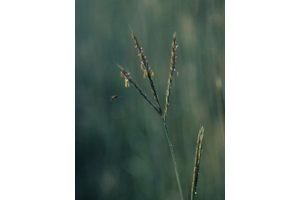Big bluestem is being rediscovered as commercial hay and a forage plant. Its leaves are very nutritious for cattle, and cows and bison love it. Prairie chickens and some songbirds consume the seeds. This species provides both food and cover for numerous livestock and wildlife species. Upland game birds and songbirds eat the seeds.
Photo Credit: © Sally and Andy Wasowski, Lady Bird Johnson Wildflower Center, wildflower.org.
Andropogon gerardii
Common Name: big bluestem
Other Common Names: bluejoint, turkeyfoot
Plant Functional Group: Graminoid
Class > Order > Family: Magnoliopsida > Poales > Poaceae
What does the species look like?
Big bluestem is a perennial bunchgrass growing 3 to 10 feet tall. Its green flowers are small and inconspicuous and arranged along finger-like spikes. They are wind-pollinated.
Big bluestem occurs in arid landscapes or on dry slopes. It prefers the deep, fertile, dry soils of prairies, plains, and open woods, but also grows on shallow, gravelly ridges during wet periods.
Where is the species found?
States & Provinces
AL, AR, AZ, CO, CT, DC, DE, FL, GA, IA, IL, IN, KS, KY, LA, MA, MB, MD, ME, MI, MN, MO, MS, MT, NC, ND, NE, NH, NJ, NM, NY, OH, OK, ON, PA, QC, RI, SC, SD, SK, TN, TX, UT, VA, VT, WI, WV, WY
Special Considerations for Observing
If drought seems to be the cause of leaf withering for a plant, please make a comment to that effect.
Which phenophases should I observe?
Do you see...?
Leaves
Initial growth More...
Leaves More...
What percentage of the plant is green?
Less than 5% 5-24% 25-49% 50-74% 75-94% 95% or more
Flowers
Flower heads More...
How many fresh flower heads are present?
Less than 3 3 to 10 11 to 100 101 to 1,000 More than 1,000
Open flowers More...
What percentage of all fresh flowers (unopened plus open) on the plant are open?
Less than 5% 5-24% 25-49% 50-74% 75-94% 95% or more
Pollen release More...
How much pollen is released?
Little: Only a few grains are released. Some: Many grains are released. Lots: A layer of pollen covers your palm, or a cloud of pollen can be seen in the air when the wind blows
Fruits
Fruits Andropogon gerardii , the fruit is a tiny grain, closely arranged along a few spike-like branches that arise together near the base of the seed head, that changes texture from soft or watery to hard and drops from the plant. Do not include seed heads that have already dropped all of their grains.More...
How many fruits are present?
Less than 3 3 to 10 11 to 100 101 to 1,000 More than 1,000
Ripe fruits Andropogon gerardii , a fruit is considered ripe when it is hard when squeezed and difficult to divide with a fingernail, or when it readily drops from the plant when touched.More...
What percentage of all fruits (unripe plus ripe) on the plant are ripe?
Less than 5% 5-24% 25-49% 50-74% 75-94% 95% or more
Recent fruit or seed drop More...
How many mature fruits have dropped seeds or have completely dropped or been removed from the plant since your last visit?
Less than 3 3 to 10 11 to 100 101 to 1,000 More than 1,000
What do these phenophases look like?
There is currently no photoguide available for this species. If you'd like help us create one, use the guidance document and species template provided here . Then send it via email to education@usanpn.org when it is complete.
